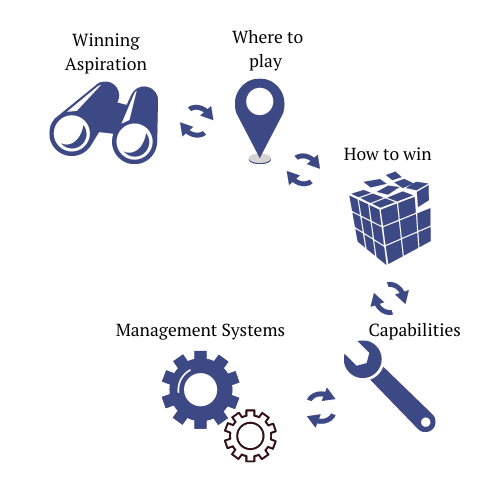The strategy choice cascade. Where to play and how to win.
Category:The strategy choice cascade. Where to play and how to win.
Contents |
Abstract
The Strategy Choice Cascade is a methodology that analyzes the critical elements of the strategic alternative of interests. Moreover, it is a way for a team to visualize and discuss different approaches towards future projects. The Strategy Choice Cascade was designed at Procter & Gamble and is discussed in A. G. Lafley and Roger L. Martin's book 'Play to Win: How Strategy Really Works.' A strong strategy will generate a durable advantage and higher value in the competitive market. This article serves as a guide for articulating a strategy or strategic possibility as an integrated collection of choices that uniquely places a company, project or product in its industry.
Mention how this is applicable to project managers.
Mention that the article provides hands on guidance, the reader (at least prototypically) can apply the method after reading the article.
The strategy choice cascade
The value of framing your strategy
Strategy is an integrated collection of choices that generate a durable advantage and differentiate a project or company from the market competitors. Every facet of a business is affected by strategy, from employees to partnerships, services to sales channels, consumers to competitors.
Moreover, in project management a well defined strategy framework leads to designing milestones that align with the company's goals. Several strategy approaches and frameworks exist to assist managers in dealing with this level of complexity. A strategic framework is a tool that assists managers in portraying how a project meets corporate and customer goals in a systematic and organised way. Implementing a strategic framework in a project has a number of advantages. A strategy framework will set the pillars to future projects, managers will identify the market of interest, the differentiation plan as well as the management systems required. On the deliverables, managers will have the foundations of a project communication plan which will enable an effective communication with employees, customers, and other stakeholders. The framework also requires thinking about project interconnections, which will help decide which initiatives are worthwhile today and which can be of more interest at a later time. This cascade is comprised of five key elements:
- The winning aspiration. This phase is all about establishing what the project aims to achieve and what would make it successful.
- Where to play. The playing field on which the project will compete.
- How to win. How to come out on top. Winning implies outperforming competitors in terms of customer value equation. There are two approaches to achieve a competitive edge, become either a differentiator or a cost leader.
- Capabilities. The set of activities that a management must complete in order to gain a competitive edge.
- Management Systems. Metrics and Systems that facilitate the capabilities and choices that constitute the strategy.
